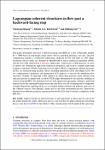Lagrangian coherent structures in flow past a backward-facing step
| dc.contributor.author | Huang, C | |
| dc.contributor.author | Borthwick, AGL | |
| dc.contributor.author | Lin, Z | |
| dc.date.accessioned | 2023-08-16T09:17:47Z | |
| dc.date.available | 2023-08-16T09:17:47Z | |
| dc.date.issued | 2022-09-25 | |
| dc.identifier.issn | 0022-1120 | |
| dc.identifier.issn | 1469-7645 | |
| dc.identifier.other | A4 | |
| dc.identifier.uri | https://pearl.plymouth.ac.uk/handle/10026.1/21239 | |
| dc.description.abstract |
This paper investigates flow past a backward-facing step (BFS) in a duct at Reynolds number Re = 5080 based on step height, mean inflow velocity and fluid kinematic viscosity. The flow configuration matches a combustion experiment conducted by Pitz and Daily in 1983. High-resolution velocity fields are obtained in OpenFOAM by direct numerical simulation, and the flow field analysed by Lagrangian approaches. Trajectories of fluid particles in areas of interest are obtained by high-order numerical integration, and used to compute finite-time Lyapunov exponents (FTLEs) and polar rotation angles. Lagrangian coherent structures (LCSs) are extracted using geodesic theory, including hyperbolic LCSs and elliptic LCSs. We use complementary qualitative and quantitative LCS analyses to uncover the underlying flow structures. Notably, we find that a flow pathway in which fluid particles rarely diverge from adjacent particles is opened and closed by FTLE ridges determined by the periodic shedding of vortices from the BFS. Two dominant vortices with significant Lagrangian coherence, generated respectively by the separated boundary layer and shear layer, are self-sustaining and of comparable strength. Hyperbolic repelling LCSs act as transport barriers between the pathway and cores of the coherent vortices, thus playing a major part in the fluid entrainment process. Interactions between these different geometric regions partitioned by LCSs lead to intrinsic complexity in the BFS flow. | |
| dc.format.extent | a4- | |
| dc.language | en | |
| dc.publisher | Cambridge University Press (CUP) | |
| dc.subject | vortex interactions | |
| dc.subject | boundary layer structure | |
| dc.subject | separated flows | |
| dc.title | Lagrangian coherent structures in flow past a backward-facing step | |
| dc.type | journal-article | |
| dc.type | Article | |
| plymouth.author-url | https://www.webofscience.com/api/gateway?GWVersion=2&SrcApp=PARTNER_APP&SrcAuth=LinksAMR&KeyUT=WOS:000840852800001&DestLinkType=FullRecord&DestApp=ALL_WOS&UsrCustomerID=11bb513d99f797142bcfeffcc58ea008 | |
| plymouth.volume | 947 | |
| plymouth.publication-status | Published | |
| plymouth.journal | Journal of Fluid Mechanics | |
| dc.identifier.doi | 10.1017/jfm.2022.631 | |
| plymouth.organisational-group | |Plymouth | |
| plymouth.organisational-group | |Plymouth|Faculty of Science and Engineering | |
| plymouth.organisational-group | |Plymouth|Faculty of Science and Engineering|School of Engineering, Computing and Mathematics | |
| plymouth.organisational-group | |Plymouth|Users by role | |
| plymouth.organisational-group | |Plymouth|Users by role|Academics | |
| dcterms.dateAccepted | 2022-07-18 | |
| dc.date.updated | 2023-08-16T09:17:34Z | |
| dc.rights.embargodate | 2023-9-6 | |
| dc.identifier.eissn | 1469-7645 | |
| dc.rights.embargoperiod | forever | |
| rioxxterms.versionofrecord | 10.1017/jfm.2022.631 |


